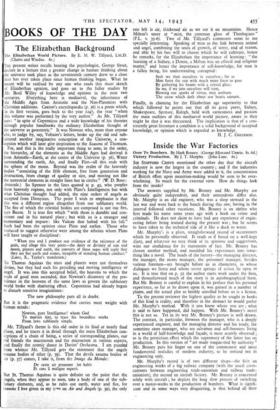BOOKS OF THE DAY
The Elizabethan Background
The Elizabethan World Picture. By E. M. W. Tillyard, (Chatto and Windus. 6s.) THE present writer recalls hearing the psychologist, George Stout, declare in a lecture that a greater change in human thinking about 'the universe took place. as the seventeenth century drew to a dose than has ever taken place since human thinking began. What he meant will be realised by any one who reads this short sketch of Elizabethan opinion, and goes on to the fuller studies by Mr. Basil Willey of knowledge and opinion in the next two centuries. EVerything here is mediaeval, the inheritance of the Middle Ages from Aristotle and the Neo-Platonists with Christian additions. Caxton's encyclopaedia (p. 36) is a poem which, in its first version, goes back to the year 5247, the year " when this volume was performed by the very author." As Mr. Tillyard says: "in spite of Copernicus and a wide knowledge of his theories through popular handbooks the ordinary Elizabethan thought of the universe as geocentric." It was Newton who, more than anyone else, to judge by, say, Voltaire's letters, broke up the old and sub- stituted another imaginative conception of the Universe, a con- ception which will later give inspiration to the Seasons of Thomson. For, and this is the really important thing to note, in the order, the hierarchy, of the elements as the Middle Ages had derived it from Aristotle—Earth, at the centre of the Universe (p. 56), Water surrounding the earth, Air, and finally Fire—all this ends with the sphere of the moon. Beyond was the realm of the heavenly bodies "consisting of the fifth element, free from generation and destruction, from change of quality or size, and moving not lilte the terrestrial elements in straight lines but in circles." (W. D. Ross : Aristotle.) So Spenser in the lines quoted at p. 45, who peoples these heavenly regions, not only with Plato's Intelligences but with what Christian thought had added, the nine orders of angels as accepted from Dionysius. The point I wish to emphasise is that this was a different region altogether from our sublunary world. The fire of which the celestial bodies are composed is not our fire, says Bacon. It is true fire which " with them is durable and con- sistent and in his natural place ; but with us is a stranger and -momentary and impure: like Vulcan that halted with his fall." Such had been the opinion since Plato and earlier. Those who ventured to suggest otherwise were among the atheists whom Plato will have taught or disciplined: " When you and I produce our evidence of the existence of the gods, and allege this very point—the deity or divinity of sun and moon, planets and earth, the converts of these sages will reply that they are but earth and stones, incapable of minding human conduct." (Laws, X., Taylor's translation.) To Thomas Aquinas the stars and planets were not themselves divine, but they had each his presiding and moving intelligence or angel. It was into this accepted belief, the heavens to which the souls of good men ascended, that Newton's discovery of the pre- valence in the heavens of the same laws as govern the sublunary world broke with shattering effect. Copernicus had already begun to disturb sensitive imaginations:
The new philosophy puts all in doubt.
But it is the pragmatic evidence that carries most weight with human minds: Newton, pure Intelligence! whom God
To mortals lent, to trace his boundless works.
From laws sublimely simple.
Mr. Tillyard's theme is this old order in its final or heady final phase, and he traces it in detail through the main Elizabethan con- ceptions of a chain of being, a series of corresponding planes, our old friends the macrocosm and the microcosm in various aspects, and finally the cosmic dance in Davies' Orchestra. I am puzzled from whence Mr. Tillyard gets the statement that the angels assume bodies of ether (p. 39). That the devils assume bodies of air (p. 57) comes, I take it, from the Image du Monde: De ceste air prennent for habit Et curs li malign esperit.
But St. Thomas Aquinas is quite definite on the point that the, angels, when they appear to men, take a body of one of the sub- lunary elements, and, as he rules out earth, water and fire, for reasons I hve given in my :-.."*e on Air and Angels (p. 39), the only
one left is air, thickened air as we see it on mountains. Hence Milton's sneer at " mist, the common gloss of Theologians" (P.L. v. 35-6). Two of Mr. Tillyard's comments seem to me specially interesting. Speaking of man as the link between animal and angel, combining the souls of growth, of sense, and of reason, and able by his free will to choose which he will cultivate, hence he remarks, for the Elizabethan the importance of learning : " the learning of a Sidney, a Donne, a Milton was an ethical and religious matter," and hence the importance of self-knowledge, for man is a fallen being, his understanding corrupted:
Seek we then ourselves in ourselves ; for as Men force the sun with much more force to pass By gathering his beams with a crystal glass: So we, if we into ourselves will turn, Blowing our sparks of virtue, may outbum The straw which cloth about our hearts sojourn.
Finally, in claiming for the Elizabethan age superiority to that which followed he points out that all its great poets, Sidney, Shakespeare, Spenser, Ralegh, held with earnestness and passion the main outlines of this mediaeval world picture, aware as they might be that it was threatened. The implication is that of a con- sistently great literature a condition is a solid background of accepted knowledge, or opinion which is regarded as knowledge.
H. J. C. GRIERSON.


























 Previous page
Previous page